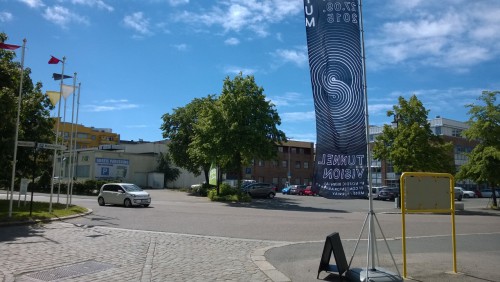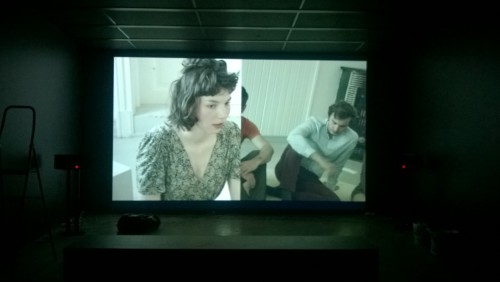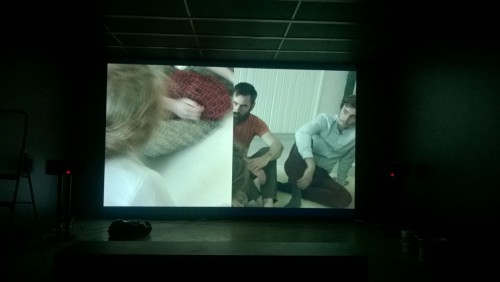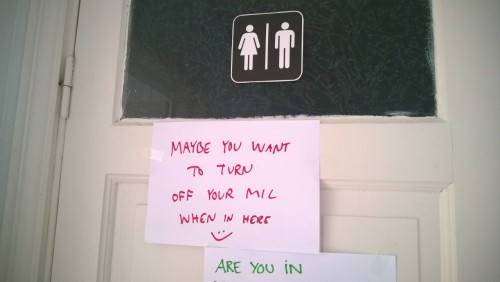I’m standing in front of a wall. It’s made of wood, painted white. There are two black, small holes, probably made by nails, at my eye level. I run my hand along the surface of the white paint. I’m in the present, aware of what’s right in front of me.
I’m playing in a larp called The Zeigarnik Effect, run in Moss in Norway 11th – 13th of June, 2015 as part of the Momentum biennial of contemporary art. Created by the artist Brody Condon, The Zeigarnik Effect consists of two complementary but separate pieces, the larp and a video installation based on material recorded in the larp. During the opening of Momentum, the camera feeds from the larp are displayed live at the installation.

The voice tells me, tells all of us to move our focus to the other people in the room. I turn around and face the room. I see the other participants. I look at their faces. I look at their eyes. I’m aware of their presence. I’m in the moment.
One of the core inspirations of The Zeigarnik Effect is the Gestalt therapy of the German psychotherapist Fritz Perls. Being in the moment, being present, is one of the ideas that makes Gestalt therapy so interesting to experience. We play loose characters that consist of motivations for being in therapy, and little else. The specific rituals of Gestalt mean that although everyone in the group is in close, constant interaction with everyone else, we don’t really need anything very elaborate in terms of larp fiction. I have little else than the simple motivation granted to me by my imagined affliction, and it sufficed.

The voice is telling me to focus on my body. I feel the cramping in my back, the itching in my scalp and the anxiety in my fingers created by the condition I came up with: The fear of losing sensation in my hands and feet.
When we’re not doing mental and social excercises designed to bring us into the present moment, we’re working on someone. The language of Gestalt foregrounds the experiential, meaning that when we describe dreams, it sounds like this: “I’m experiencing remembering standing on a brown granual surface. It’s dark. I feel the heat on my face.” And so forth.
The ideas of Gestalt therapy, combined with the game design features designed by Condon with Nina Runa Essendrop, create a series of extremely intense, socially high-resolution interactions that are sometimes joyful and always interesting. A particular favorite is an excercise in which half the group moves eyes closed and the other half guides them, forcefully or with only a light touch.
In another interesting excercise, one participant asks the question “What do you want?” over and over again, and the other tries to answer. When I do this, I end up tearing my partner’s t-shirt into two. When it’s his turn to answer, he hits me in the face.

Playing The Zeigarnik Effect feels like someone has constructed an experimental language of larp, something honed and perfected in earlier prototypes until it runs smoothly and efficiently. Everything is simple, but I’m aware that to reach this level of simplicity, a great deal effort and trial and error is necessary.
The documentation required by the video installation is rigorous and thorough. Implemented by Paul Shin, the set-up includes wireless microphones on every participant and two cameramen who move in the game space, capturing emotions in close up.

Visiting the installation space, it’s obvious that this strategy really pays off. Capturing the visual surface of larp has rarely been done to such powerful effect as here, and the key is making sure that the camera is always right there, zeroing in on the face of someone who is not performing.
thanks for this lovely report! brings back memories of my Level5 participation
Juhanna Pettersson-thank you for this report on Brody Condon’s Ziegarnik effect. I’m wondering if you know anyone/others involved in high-fantasy Nordic larping? I’d like to join a game next summer but get involved sooner. I’m not a ‘gamer’ though and have really noises where to start. If you have any info, I’d appreciate it. Thanks
Sorry for the late reply, I only noticed your comment now. If you still need recommendations about Nordic fantasy larps, hit me at jlp@iki.fi